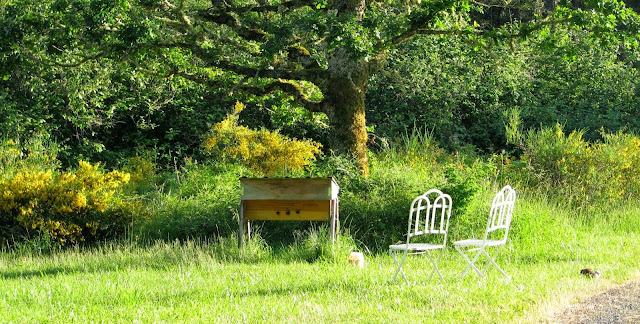
Several hours of picking over a couple of days got us a fair number of apples.
Gravs don't keep, so you eat them right now, cook them or squeeze them. We did some cooking and eating, but the squeezing is the big job.
Our press is a homemade, picked up from a 2nd hand store 10 years ago or so. You can see it in action in the video below.
It has a shredder powered by a small electric motor. It is a fierce device. Apples go in whole, stems and all, and come out in bits. The PVC cylinders catch the chunks. When full they get slid down under the press, which is a screw jack. Tighten until it gushes, then let it finish.
It gets poured from the catch pan, through a sieve and a funnel, into clean water jugs. I don't use cleaned out milk jugs; I worry to much about the unpasturized juice and the possibility of something going wrong. So only clean, new jugs for me.
We squeezed over 12 gallons, and still had a bushel of apples to share with friends. The juice goes into the freezer, to be thawed out in October when the rest of the trees are ripe and we can do some blending.
The squeezed bits go back into the soil. The chickens are temporarily interested, but there are so many apples on the ground that they have their fill all fall.
I have a mixed relationship with squeezing apples. It is a lot of work to get the apples down, get enough to press, then store and clean up. This is such a busy time of year, and it is always HOT when it is time to pick.
But I am always glad that I did it. This year was made even better because both of the kids were home to help. Jake has been away for so long he has never squeezed apples. June has, but she has been traveling and living elsewhere, so we don't get a lot of time with both of them here. Having them, and our new friend Hank, there to help was the best part of the process.
Since neither Hank nor Jake had squeezed before, they had not tasted the fresh, raw juice. Gotta have a little tasting before the clean up. It was wonderful.
The ground is still littered with apples, slowly rotting. There are some left in the tree, including the ever tantalizing big ones out of reach at the top. The other trees' apples are still growing, the branches are straining and sometimes breaking. The press is cleaned up and put in the shed, until October, when the weather will be cooler, friends will gather, and more cider will be squeezed.




















